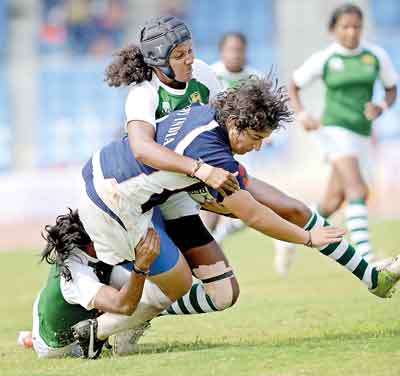Indian President of Asian Rugby Football Union
View(s):Rugby Asia takes a new turn as Aga Hussein from India Rugby takes over as President of the Asian Rugby Football Union (ARFU). Hussein has been involved in the promotion of Rugby in India and served the ARFU ExCo for many years, and was elected at the ARFU AGM. With the Rugby World Cup to be held in Japan in 2019, will this be the opportunity for India to fall in love with the oval ball game.
 Hussein rose to the position, after having been first elected to the ExCo in 2010. The two vice presidents (VP) elected are Fawzi Kawaji of Pakistan and Yuichi Ueno of Japan. The ARFU, in its revised constitution, opted to do away with the post of Secretary, and instead appointed two vice presidents.
Hussein rose to the position, after having been first elected to the ExCo in 2010. The two vice presidents (VP) elected are Fawzi Kawaji of Pakistan and Yuichi Ueno of Japan. The ARFU, in its revised constitution, opted to do away with the post of Secretary, and instead appointed two vice presidents.
There was speculation that Sri Lanka Rugby (SLR) President Asanga Seneviratne, was to contest for vice president. Reports are hazy, as some say he contested, while others say he withdrew his nomination. He was appointed to the executive committee. The question is not whether he contested and lost or, withdrew, as either way it shows a loss of support. Another opportunity will arrive in two years. Compared with Sri Lanka, Rugby is not a popular sport in India or Pakistan. India, however, has potential to spread Rugby among the vast population. Sri Lanka has been a Rugby-playing nation for over 100 years, while India too has had an interest in the game for virtually the same length of time, with the Calcutta Cup being one of the oldest events in Rugby.
However, the game took a back seat, but was emergent in recent times, still retaining more of the amateur status. Till a few years ago, India was an Associate member. Sri Lanka, unlike India and Pakistan, has a larger following and also played Rugby at a higher level in Asia. Pakistan Rugby is virtually at a crawling stage in the life cycle of the game. The pointer, possibly, is that Asia looks strategically at the potential. The present President is from Japan, and they will have another in line after the current term ends.
At the same time of losing a place as a possible VP of Asian Rugby, CR&FC, the glory boys of the previous week, lost to CH&FC, exposing them to being vulnerable and failed to reach the fruits of joy. CH who have been struggling over the last 30 matches, showed their determination against odds. Hopefully, this win will help them find more to fill their bench as they progress.
Navy redeemed lost prestige by beating Havelocks, to stay in contention. Kandy SC remains unbeaten, while CR, Havelocks and Navy have won two out of three played to date. Navy must shake off being a first-half side, as they will meet Kandy in the weeks ahead. Against CR, they lost after leading 23-7 at the break, failing to score in the second session. In the match against Havelocks, they were leading 20-7 at the ‘breather’, but managed only three more points, thanks to a brilliant drop-goal. Lethargy denied them their fourth try and the bonus points.
Luck was with them, as Havelocks managed to score with only a few minutes to go. Havelocks appeared to be woeful in their ability to finish off, after having more territory for most of the second half. They need to tie up their loose ends, as they have to play Kandy and CR in the weeks ahead. it appeared there was less harmony between the backs and forwards, as the big boys cried the runners were wasting the good ball won by hard work. The backs, on the other hand, were grumbling against the men up front.
 Watching Rugby in the first three weeks made me wonder what is happening to players who boast of coming with a school Rugby background. The ability to hold on to or catch a pass to retain possession was questionable. The incidents that drew yellow and red cards on field needs serious attention. Teams cannot afford to lose players from sanctions, as absence will always favour the opponents.
Watching Rugby in the first three weeks made me wonder what is happening to players who boast of coming with a school Rugby background. The ability to hold on to or catch a pass to retain possession was questionable. The incidents that drew yellow and red cards on field needs serious attention. Teams cannot afford to lose players from sanctions, as absence will always favour the opponents.
Sometimes it is sheer negligence, while at other times it is attitude coupled with less knowledge of the current thinking. There was a time in the game between CH and CR, where there were many unsteady scrums. The referee sensing something, moved to the non-throwing side, only to see a pull down with a clear elbow perpendicular to the ground, and a clear twist on being shown the yellow. The look on the player was something like ‘WTF’ is that for. On another occasion, in the CH-Kandy match, there was a boot that went to the head of a player and the explanation by people is the player went for the ball. The question is whether it was reckless or accidental. Clarified in November 2016, under the heading ‘Reckless Tackle’, it says “A player is deemed to have made reckless contact during a tackle or attempted tackle or during other phases of the game if, in making contact, the player knew or should have known there was a risk of making contact with the head of an opponent, but did so anyway”. The key is “during other phases of the game”. That is something that has to be understood. There are many similar issues with people shouting “this is not Netball’. True, it is not. But the accent of World Rugby being on player welfare, the tendency for referees is to reach for the the card in the pocket.
Vimal Perera is a former Rugby Referee, Coach and a former Accredited Referees’ Evaluator IRB


